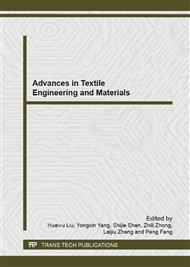p.225
p.229
p.233
p.239
p.243
p.248
p.252
p.258
p.263
Sulfuric Acid Treatment of Aramid Fiber for Improving the Cationic Dyeing Performance
Abstract:
In order to improve the cationic dyeing performance of para-aramid fiber, the optimal conditions of fiber pretreatment were determined through the orthogonal test with three-factor (sulfuric acid dosage, temperature and time) and four-level array using the tensile strength and apparent color depth of modified fabrics as the main evaluation criteria. Scanning electron microscope and Fourier transform infrared analyses were used to study the changes in the morphological structure and chemical groups of fibers due to modification. The results showed that the modified para-aramid fiber displayed a smoother surface, and the acid hydrolysis of polymer molecules occurred. The treatment increased the number of reactive dyeing sites on fiber surface and consequently improved the dyeing performance of para-aramid fabric. The optimal process for the modification of para-aramid fiber with sulfuric acid treatment was 2% dosage of sulfuric acid at 40°C for 1 hour. The modified and dyed fabrics showed obviously increased color depth and color fastness to rubbing and washing.
Info:
Periodical:
Pages:
243-247
Citation:
Online since:
December 2012
Authors:
Price:
Сopyright:
© 2013 Trans Tech Publications Ltd. All Rights Reserved
Share:
Citation:


